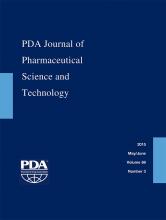Abstract
The purpose of this article is to recommend a risk-based strategy for determining clearance testing requirements of the process reagents used in manufacturing biopharmaceutical products. The strategy takes account of four risk factors. Firstly, the process reagents are classified into two categories according to their safety profile and history of use: generally recognized as safe (GRAS) and potential safety concern (PSC) reagents. The clearance testing of GRAS reagents can be eliminated because of their safe use historically and process capability to remove these reagents. An estimated safety margin (Se) value, a ratio of the exposure limit to the estimated maximum reagent amount, is then used to evaluate the necessity for testing the PSC reagents at an early development stage. The Se value is calculated from two risk factors, the starting PSC reagent amount per maximum product dose (Me), and the exposure limit (Le). A worst-case scenario is assumed to estimate the Me value, that is common. The PSC reagent of interest is co-purified with the product and no clearance occurs throughout the entire purification process. No clearance testing is required for this PSC reagent if its Se value is ≥1; otherwise clearance testing is needed. Finally, the point of the process reagent introduction to the process is also considered in determining the necessity of the clearance testing for process reagents. How to use the measured safety margin as a criterion for determining PSC reagent testing at process characterization, process validation, and commercial production stages are also described.
LAY ABSTRACT:A large number of process reagents are used in the biopharmaceutical manufacturing to control the process performance. Clearance testing for all of the process reagents will be an enormous analytical task. In this article, a risk-based strategy is described to eliminate unnecessary clearance testing for majority of the process reagents using four risk factors. The risk factors included in the strategy are (i) safety profile of the reagents, (ii) the starting amount of the process reagents used in the manufacturing process, (iii) the maximum dose of the product, and (iv) the point of introduction of the process reagents in the process. The implementation of the risk-based strategy can eliminate clearance testing for approximately 90% of the process reagents used in the manufacturing processes. This science-based strategy allows us to ensure patient safety and meet regulatory agency expectations throughout the product development life cycle.
- Clearance testing strategy
- Process reagents
- Process-related impurity
- Safety margin
- GRAS reagents
- PSC reagents
- © PDA, Inc. 2015
PDA members receive access to all articles published in the current year and previous volume year. Institutional subscribers received access to all content. Log in below to receive access to this article if you are either of these.
If you are neither or you are a PDA member trying to access an article outside of your membership license, then you must purchase access to this article (below). If you do not have a username or password for JPST, you will be required to create an account prior to purchasing.
Full issue PDFs are for PDA members only.
Note to pda.org users
The PDA and PDA bookstore websites (www.pda.org and www.pda.org/bookstore) are separate websites from the PDA JPST website. When you first join PDA, your initial UserID and Password are sent to HighWirePress to create your PDA JPST account. Subsequent UserrID and Password changes required at the PDA websites will not pass on to PDA JPST and vice versa. If you forget your PDA JPST UserID and/or Password, you can request help to retrieve UserID and reset Password below.






